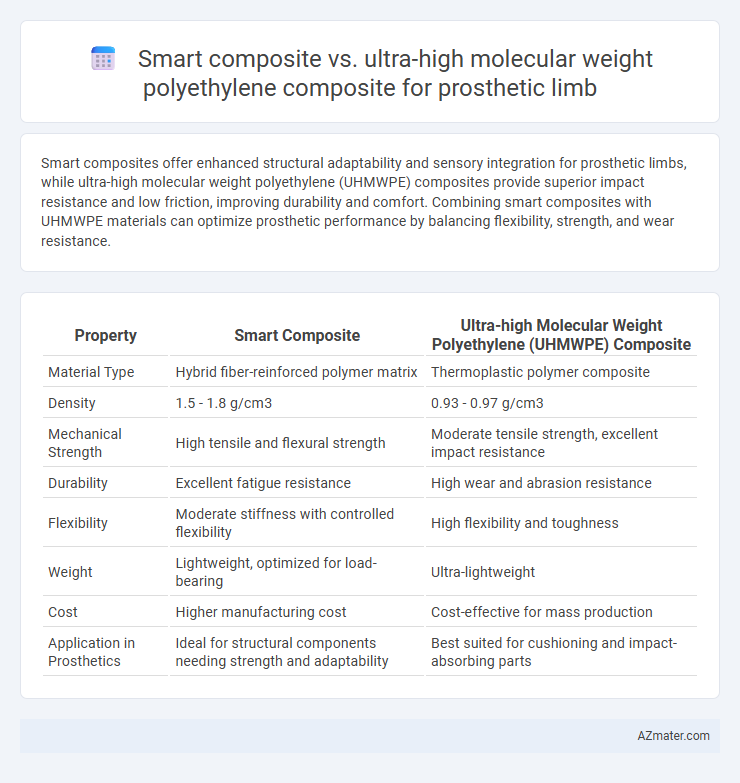Smart composites offer enhanced structural adaptability and sensory integration for prosthetic limbs, while ultra-high molecular weight polyethylene (UHMWPE) composites provide superior impact resistance and low friction, improving durability and comfort. Combining smart composites with UHMWPE materials can optimize prosthetic performance by balancing flexibility, strength, and wear resistance.
Table of Comparison
| Property | Smart Composite | Ultra-high Molecular Weight Polyethylene (UHMWPE) Composite |
|---|---|---|
| Material Type | Hybrid fiber-reinforced polymer matrix | Thermoplastic polymer composite |
| Density | 1.5 - 1.8 g/cm3 | 0.93 - 0.97 g/cm3 |
| Mechanical Strength | High tensile and flexural strength | Moderate tensile strength, excellent impact resistance |
| Durability | Excellent fatigue resistance | High wear and abrasion resistance |
| Flexibility | Moderate stiffness with controlled flexibility | High flexibility and toughness |
| Weight | Lightweight, optimized for load-bearing | Ultra-lightweight |
| Cost | Higher manufacturing cost | Cost-effective for mass production |
| Application in Prosthetics | Ideal for structural components needing strength and adaptability | Best suited for cushioning and impact-absorbing parts |
Introduction to Prosthetic Limb Materials
Prosthetic limb materials have evolved to enhance strength, flexibility, and durability, with smart composites offering adaptive properties through embedded sensors and responsive fibers. Ultra-high molecular weight polyethylene (UHMWPE) composites provide exceptional wear resistance and lightweight characteristics, crucial for comfort and longevity in prosthetic applications. Comparative analysis highlights smart composites for their real-time adaptability, whereas UHMWPE composites excel in mechanical robustness and biocompatibility.
Overview of Smart Composites
Smart composites in prosthetic limbs integrate sensors and actuators within advanced polymer matrices to enhance adaptability and functionality. These materials enable real-time response to environmental stimuli, improving user comfort and mobility through dynamic load distribution and controlled stiffness. Unlike traditional composites such as ultra-high molecular weight polyethylene (UHMWPE), smart composites offer superior customization and feedback capabilities, advancing prosthetic limb performance significantly.
Ultra-high Molecular Weight Polyethylene (UHMWPE) Composites Explained
Ultra-high molecular weight polyethylene (UHMWPE) composites exhibit exceptional strength-to-weight ratios and impact resistance, making them ideal for prosthetic limb applications requiring durability and flexibility. Their chemical inertness and low friction properties enhance comfort and longevity in prosthetic socket interfaces, reducing wear and maintenance needs. Compared to smart composites, UHMWPE composites offer superior biocompatibility and fatigue resistance, ensuring reliable performance under repetitive mechanical stress.
Mechanical Properties Comparison
Smart composites demonstrate superior mechanical properties such as enhanced tensile strength, impact resistance, and flexibility compared to ultra-high molecular weight polyethylene (UHMWPE) composites in prosthetic limbs. UHMWPE composites offer excellent abrasion resistance and low friction but generally exhibit lower stiffness and strength, which may limit load-bearing capacity in advanced prosthetic applications. The integration of smart materials in composites allows for adaptive mechanical performance, optimizing durability and user comfort under varying stress conditions.
Weight and Comfort Considerations
Smart composites used in prosthetic limbs offer enhanced weight reduction due to their tailored fiber orientations and resin matrices, significantly improving user comfort by minimizing limb fatigue. Ultra-high molecular weight polyethylene (UHMWPE) composites provide superior impact resistance and lightweight properties but may lack the adaptive flexibility of smart composites, influencing wearer comfort during extended use. Weight optimization in smart composites directly correlates with improved load distribution and reduced skin irritation, critical factors for prosthetic limb users prioritizing comfort.
Durability and Longevity
Smart composites for prosthetic limbs offer enhanced durability through adaptive material properties that respond to stress and environmental changes, prolonging structural integrity. Ultra-high molecular weight polyethylene (UHMWPE) composites provide exceptional wear resistance and low friction, significantly extending the lifespan of prosthetic components under repetitive mechanical loads. Comparative studies indicate UHMWPE composites excel in longevity for high-impact activities, while smart composites deliver optimized performance in variable dynamic conditions.
Biocompatibility and Safety
Smart composites and ultra-high molecular weight polyethylene (UHMWPE) composites both offer excellent biocompatibility for prosthetic limbs, with UHMWPE recognized for its low wear rate and non-toxicity, reducing the risk of inflammatory responses. Smart composites, often integrating sensor technology, provide enhanced safety by enabling real-time monitoring of stress and strain, which helps prevent mechanical failures. The integration of smart composites improves long-term limb performance and user comfort through adaptive responses, while UHMWPE composites ensure durability and minimal adverse tissue reactions.
Cost and Accessibility
Smart composites for prosthetic limbs, often comprising advanced materials like carbon fiber reinforced polymers, generally offer higher strength-to-weight ratios but come with elevated manufacturing costs that limit accessibility in low-resource settings. Ultra-high molecular weight polyethylene (UHMWPE) composites present a cost-effective alternative due to their lower production expenses and widespread availability, enabling broader access to prosthetic devices. The economic feasibility and material affordability of UHMWPE composites contribute significantly to their adoption in affordable prosthetic limb solutions worldwide.
Performance in Real-world Applications
Smart composites in prosthetic limbs offer adaptive stiffness and real-time responsiveness, enhancing gait efficiency and user comfort in dynamic environments. Ultra-high molecular weight polyethylene (UHMWPE) composites provide exceptional impact resistance and lightweight durability, ideal for high-load activities and long-term wear. Real-world studies demonstrate smart composites excel in personalized motion control, while UHMWPE composites deliver superior structural integrity and abrasion resistance during intensive use.
Future Trends in Prosthetic Limb Materials
Smart composites featuring embedded sensors and adaptive materials demonstrate significant potential for next-generation prosthetic limbs by enabling real-time responsiveness and improved user comfort. Ultra-high molecular weight polyethylene (UHMWPE) composites offer exceptional strength-to-weight ratios and biocompatibility, making them ideal for durable and lightweight prosthetic components. Future trends indicate a convergence of smart composite technology with advanced UHMWPE materials to create prosthetics that combine mechanical resilience with intelligent functionality, enhancing mobility and user experience.

Infographic: Smart composite vs Ultra-high molecular weight polyethylene composite for Prosthetic limb
 azmater.com
azmater.com